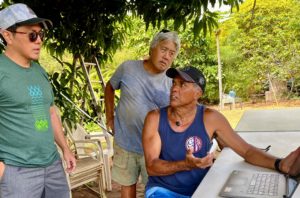Pōʻai Wai Ola and Nā Kiaʻi Kai call the “midnight rubberstamp” a violation of Hawaiʻi’s protections for streams and the environment

Uncle John looks on, as Uncle Kawai shows Isaac Moriwake studies showing the harm to reefs from polluted run-off on the Westside.
On February 6, 2023, kalo farmers and subsistence fishers from West Kauaʻi filed suit against the Hawaiʻi Department of Land and Natural Resources (DLNR) for failing to require an Environmental Impact Statement (EIS) on the major hydro project being proposed for the Waimea River. The project’s environmental assessment (EA) and “finding of no significant impact” was approved by out-going DLNR Chairperson Suzanne Case, during her last week in the position, right before the Christmas holidays, and without any public hearings.
“DLNR cannot issue a 65-year lease for river water diversions based on the narrow and skewed inquiry of an environmental assessment,” said Elena Bryant, Associate Attorney at Earthjustice representing Pō‘ai Wai Ola and Nā Kia‘i Kai. “The deeper we dig into this situation, the shadier this story gets. We really had no choice at this point but to sue.”
The 35-page complaint details how DLNR staff were directed to expedite the environmental compliance process for the West Kauaʻi Energy Project (WKEP) being proposed by the Kauaʻi Island Utility Cooperative (KIUC) and AES Corp, a global energy company known for its poor environmental record, such as Puerto Rico and Kahuku, O‘ahu. The complaint explains how DLNR improperly delegated authority to the chairperson in 2015 to approve a “finding of no significant impact” without a public hearing and Board oversight.
“As we have said many times, we want an EIS done because water is our life. A midnight rubber stamp like this demonstrates the ineptness of DLNR ,” said Kawai Warren, leader of Nā Kia‘i Kai, who is an avid fisherman and Kekaha resident.
According to the EA, KIUC and AES expect to divert an avera
ge of 11 million gallons a day – that is 4 billion gallons a year – from the Waimea River for 65 years. The EA is silent on the foreseeable consequences of discharging much of that water onto the Mānā Plain where it would collect sediment, pesticides, and other pollution on its way out into the ocean.
“Our westside nearshore fisheries have been decimated over a hundred years due to the plantation diversions of Waimea River,” explained Warren, who has fished from West Kauaʻi
shores for decades. “And now this hydro project by KIUC and AES is proposing we return to killing the life of the Waimea River and suffocating the nearshore marine life with polluted runoff for another 65 years. It is outrageous.”
The EA identifies farming as a potential end use of the water diverted from Waimea River, but does not provide any information on if and how that would actually work, the resulting impacts if KIUC fails to follow through, and the alternatives or mitigation measures that could avoid the waste of water diverted from Waimea River and the pollution from dumping excess flow diversions.
Pōʻai Wai Ola Vice President and longtime kalo farmer, John Aʻana said “we signed an agreement with KIUC that states that any water that is released onto the Mānā Plain has to have an agricultural end use. KIUC didn’t even mention our agreement in the EA.”
Community members have tried to work cooperatively with KIUC for many years. Their negotiations resulted in two agreements to protect river flows as the first priority and avoid wasting water diverted from Waimea River. But the current attempt to ram through an EA and circumvent an EIS has brought community trust and goodwill to new lows.
“We’re not opposed to clean energy, but we are opposed to diverting and dumping river water for energy,” said Aʻana. “Bottom line, an EIS is required for this once-in-a-lifetime project and is needed to disclose and analyze all these details for the community and public.”
“KIUC’s hydro proposal is a legacy project that will affect our community well beyond our lifetimes,” said Galen Ka‘ōhi, lifelong Waimea resident, cultural practitioner, and President of Pōʻai Wai Ola. “The plantation didn’t do an EIS when it drained Waimea River a century ago. But we’re not going to make the same mistake for another century. We need an EIS to see if this project will be beneficial for the future of our grandchildren and their children. We owe that to our mo‘opuna.”
